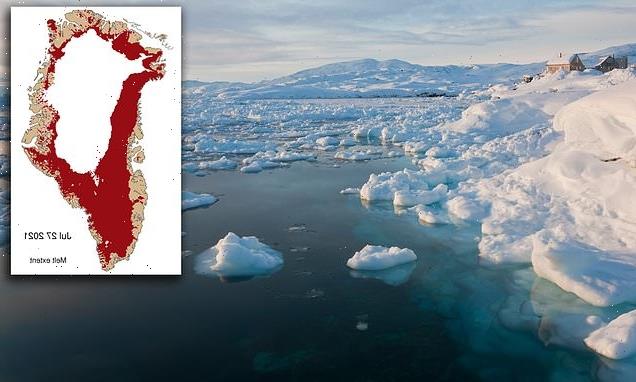Mount Etna pours lava and smoke out of volcano as it erupts
We use your sign-up to provide content in ways you’ve consented to and to improve our understanding of you. This may include adverts from us and 3rd parties based on our understanding. You can unsubscribe at any time. More info
Tenerife, Sicily and Lanzarote are among the nation’s most beloved holiday hotspots – and for good reason. The volcanic islands boast great climates and even better food, offering tourists from around the globe a small slice of paradise in the summer. But a team of researchers from Brookes Oxford University has today published a worrying report that could have grim implications for these islands, particularly in the face of climate change.
According to the study published in Nature Geoscience, researchers have found a link between changing sea levels and the likelihood of eruptions on the Greek island of Santorini.
The island, which juts out of the Aegean Sea, is the remnant of a volcanic caldera and the site of one of the biggest eruptions in recorded history – the Minoan Eruption between 1642 and 1540 BC.
The Oxford researchers took a close look at the timings of Santorini’s past eruptions over a timeline of thousands of years.
The experts found a 131ft (40m) drop in sea levels makes eruptions more likely to happen – and that could have implications for millions of people around the globe.
Lead researcher Dr Christopher Satow, Senior Lecturer in Physical Geography at Oxford Brookes, told Express.co.uk: “Our study shows that sea level has affected the timing of eruptions at the Santorini volcano.


“Many other volcanoes form islands with millions of residents and tourists.
“Many of the eruption hazard assessments for volcanic islands are based on the assumption that the volcano will behave now as it has in the past.”
But this might not be the case moving forward, especially if global warming and the melting ice caps are factored in.
Based on how the sea levels have behaved in the past, Dr Satow said the hazard assessments for volcanic islands may not be as accurate as we presently think.
He added: “It is important and pressing that hazard assessments for volcanic islands should be re-appraised in the context of present day and future sea levels.”
When Santorini erupted some 3,600 years ago, the blast caused the central part of the once conical island to sink to the sea.
The cliffs that were exposed in the process have since revealed a fascinating history of more than 200 volcanic eruptions, all preserved in the geological record.
NASA: View of Sarychev volcano eruption from ISS in 2009

The cliffs also revealed a “mechanism” that appears to influence the timings of Santorini’s eruptions.
The mechanism, according to Dr Satow, is “very simple”.
As sea levels drop, the amount of mass pushing down on the Earth’s crust drops and causes the crust to fracture.
The fractures can then allow magma to rise to the surface, feeding volcanic eruptions in the process.
Dr Satow believes the very same mechanic could be applied to other volcanoes around the world.
The expert, therefore, thinks more research needs to be done to assess the threat posed by changing sea levels on volcanic islands and “risks they pose to their populations”.


He said: “Any populated volcanic islands would benefit from research into the effect of sea level on them.
“Perhaps good examples familiar to your readers as tourist destinations would be Tenerife, Lanzarote or Sicily (Etna).”
The climate has had an impact on volcanic activity, that much is clear.
As the ice sheets retreated after the last ice age, the change in mass is believed to have induced stress into the Earth’s crust.
The stress allowed fractures that feed volcanic eruptions to form more easily.
And as the ice sheets melted, the rise of sea levels by some 328ft (100m) should have also, in theory, affected the volcanoes’ eruptive activity.
It is estimated 57 percent of the world’s volcanoes are coastal or on islands.
Many of these volcanoes sit within earshot of densely populated cities.
As a result of anthropogenic climate change, the world’s leading scientific authorities fear sea levels could drastically rise by the end of the century.
According to a 2017 estimate by the US National Oceanic and Atmospheric Administration (NOAA) sea levels are on course to rise by 8.2ft by 2100 – a moderate prediction by more recent research.
The Greenland Ice Sheet alone is estimated to raise sea levels by 20ft (6m) should the ice ever melt.
Source: Read Full Article


